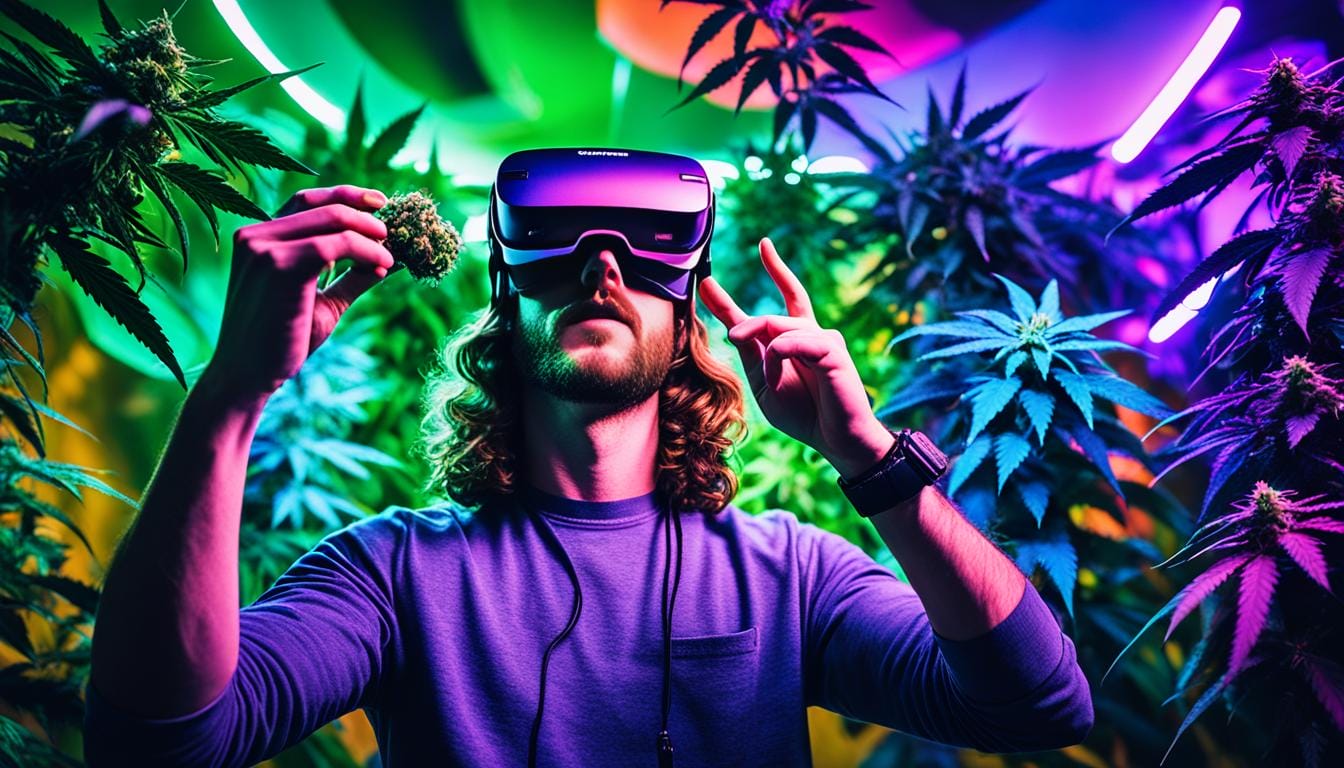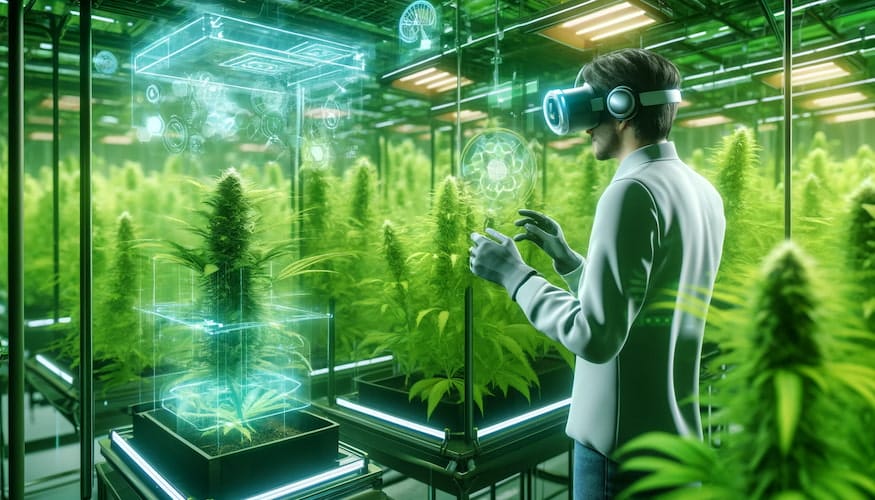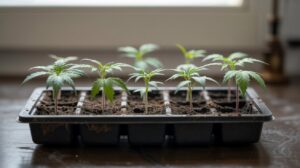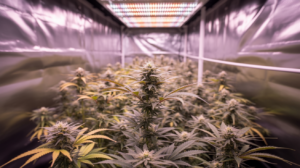Virtual Reality and Cannabis: Growing Weed in VR

Introduction
The world of marijuana cultivation is experiencing a technological revolution, thanks to virtual reality (VR). This groundbreaking technology is transforming how enthusiasts and professionals alike approach the growth and understanding of marijuana seeds. By immersing users in a virtual environment, VR provides a unique, hands-on experience that can significantly enhance the cultivation process. Imagine being able to walk through a virtual grow room, adjusting environmental factors like lighting and humidity with a simple gesture. This immersive technology allows users to gain a deeper understanding of plant development and care without the limitations and risks associated with real-world cultivation.
What’s more, VR technology offers unprecedented educational opportunities. Beginners can learn the intricacies of cannabis cultivation in a controlled, risk-free environment, while experienced growers can experiment with advanced techniques and optimization strategies. By simulating different growing conditions and scenarios, VR helps cultivators identify the best practices for maximizing yield and quality. This innovative approach not only accelerates learning but also democratizes access to expert knowledge and resources, bridging the gap between amateur growers and industry professionals. In this article, we delve into the exciting synergy between marijuana seeds and VR, exploring the numerous benefits and applications of this cutting-edge technology.
The Intersection of Marijuana Seeds and VR
Understanding Marijuana Seeds
Marijuana seeds are the foundational element of cannabis cultivation, each type offering unique characteristics and benefits. Regular seeds can produce both male and female plants, which are essential for breeding purposes. Feminized seeds, favored by many growers, ensure that only female plants—which produce the valuable buds—are cultivated, maximizing yield. Autoflowering seeds simplify the growing process by transitioning from the vegetative stage to the flowering stage automatically with age, regardless of light cycles.
Understanding the genetic variability of these seeds is crucial, as it influences the plant’s growth patterns, potency, resilience, and overall yield, enabling cultivators to make informed choices tailored to their specific cultivation goals.
Types of Marijuana Seeds
- Regular Seeds: Produce both male and female plants.
- Feminized Seeds: Ensure only female plants grow, which are the ones that produce buds.
- Autoflower Seeds: Automatically switch from the vegetative stage to the flowering stage with age, regardless of light cycles.
Genetic Variability
The genetic makeup of marijuana seeds determines the plant’s growth, potency, and resilience. Understanding plant genetics can help cultivators choose the best seeds for their specific needs, ensuring optimal growth and yield. Different strains have distinct genetic profiles that influence their cannabinoid content, flavor, aroma, and growing conditions.
| Type of Seed | Description |
|---|---|
| Regular Seeds | Produce both male and female plants; useful for breeding purposes. |
| Feminized Seeds | Only female plants grow, maximizing bud yield. |
| Auto-flowering Seeds | Automatically switch stages with age, making them ideal for beginners or those with limited time. |
The Role of VR in Marijuana Cultivation
Virtual Reality Overview
Virtual reality is an immersive technology that simulates a real-world or imagined environment, providing users with a sensory experience. In the context of marijuana cultivation, VR can recreate the growing environment, allowing users to interact with the plants in a virtual space. This immersive experience can include visual, auditory, and even haptic feedback, enhancing realism and educational value.
Benefits of Using VR
The use of VR in marijuana cultivation offers several advantages:
- Precise Control: Over the growing environment, helping cultivators monitor and adjust variables such as light, temperature, and humidity.
- Educational Platform: Enables users to learn and practice cultivation techniques without risking their actual crops.
- Remote Collaboration: Facilitates consultation and knowledge sharing with experts, regardless of location.
Advantages of VR for Marijuana Seed Cultivation
Enhanced Learning and Training
Immersive Educational Tools
VR can simulate different stages of plant growth, offering a detailed visual and interactive learning experience. This is particularly beneficial for new cultivators who can learn about the plant’s lifecycle and care requirements in a risk-free environment. VR platforms can include modules on seed germination, vegetative growth, flowering, and harvesting, providing comprehensive training.
Skill Development
By practicing in a virtual environment, cultivators can hone their skills and techniques. VR allows them to experiment with different growing methods and troubleshoot potential issues, enhancing their overall expertise. For instance, users can practice topping, pruning, and training plants to improve canopy management and increase yields. They can also simulate pest and disease management, learning how to identify and address common problems before they affect real crops.
Precision and Control
Environmental Monitoring
VR technology enables detailed monitoring of the virtual growing environment. Cultivators can simulate various conditions and observe how changes in light, temperature, and humidity affect plant growth, leading to better decision-making and optimized growing conditions. This precise control helps in creating ideal environments for different strains, improving overall plant health and productivity.
Data Collection and Analysis
The virtual environment allows for the collection of extensive data on plant growth. This data can be analyzed to identify patterns and optimize cultivation techniques, leading to higher yields and better-quality plants. By tracking variables such as growth rates, nutrient uptake, and environmental conditions, cultivators can make data-driven decisions to enhance their operations. Advanced analytics can also predict potential issues and recommend corrective actions, reducing crop losses and improving efficiency.

Applications of VR in Marijuana Cultivation
Virtual Grow Rooms
Creating Custom Grow Environments
VR can be used to design and test custom grow rooms, allowing cultivators to experiment with different layouts and setups. This can help in identifying the most efficient and effective configurations for real-world applications. Users can adjust factors such as lighting arrangements, airflow patterns, and spacing to optimize the growing environment. Virtual grow rooms also enable the simulation of different growing systems, including soil, hydroponics, and aeroponics, helping cultivators choose the best approach for their needs.
Simulating Different Strains
Different marijuana strains have varying growth requirements. VR can simulate these needs, helping cultivators understand and meet them more effectively. By virtually growing various strains, users can learn about their specific light, nutrient, and environmental preferences, leading to better strain selection and cultivation practices. This knowledge can also help develop new hybrids with desirable traits, expanding the variety of available cannabis products.
Training and Education Programs
Virtual Classes and Workshops
Educational institutions and cannabis companies can offer virtual classes and workshops using VR. These programs can provide in-depth training on various aspects of marijuana cultivation, from seed selection to harvesting techniques. Virtual workshops can cover topics such as cloning, breeding, and post-harvest processing, providing valuable knowledge to both novice and experienced growers. Interactive elements, such as quizzes and hands-on activities, can enhance engagement and retention of information.
Remote Collaboration and Consultation
VR enables remote collaboration between experts and cultivators. This can facilitate knowledge sharing and provide cultivators with access to expert advice, regardless of their geographical location. For example, a grower in a remote area can receive guidance from a master cultivator in another country through a virtual consultation. This can help in solving specific cultivation challenges and improving overall practices. Remote collaboration can also support research and development efforts, fostering innovation in the cannabis industry.
Future Prospects of VR in Marijuana Cultivation
Technological Advancements
Integration With AI and Machine Learning
The integration of VR with artificial intelligence (AI) and machine learning can further enhance the cultivation process. AI can analyze data collected in the virtual environment to provide insights and recommendations, while machine learning can help in predicting and preventing potential issues. For instance, AI algorithms can identify patterns in plant growth and environmental conditions, suggesting optimal adjustments to improve yields. Machine learning can also predict disease outbreaks or pest infestations based on historical data, allowing for proactive management.
Improved User Experience
As VR technology continues to evolve, the user experience will become more immersive and realistic. This will further enhance its applications in marijuana cultivation, making it an indispensable tool for both novice and experienced cultivators. Future advancements may include haptic feedback systems that simulate the tactile experience of handling plants, as well as more sophisticated visual and auditory effects that mimic real-world growing environments. These improvements will make VR training and simulations even more effective and engaging.
Expansion Into Other Areas of Cannabis Industry
Product Development and Testing
VR can also be used in other areas of the cannabis industry, such as product development and testing. For example, it can simulate the effects of different cannabis products on users, helping in the development of new strains and products. Virtual simulations can replicate various consumption methods, such as smoking, vaping, or edibles, and predict their effects based on cannabinoid profiles. This can aid in creating products tailored to specific medical conditions or consumer preferences.
Marketing and Sales
Virtual reality can revolutionize the marketing and sales of cannabis products. Virtual tours of grow facilities, immersive product demonstrations, and virtual try-before-you-buy experiences can enhance customer engagement and drive sales. For instance, customers can explore a virtual dispensary, learning about different strains and products before making a purchase. Virtual reality can also be used in promotional events, providing a unique and memorable experience that differentiates brands in a competitive market.

Other Advancements in Cannabis Cultivation Technology
The cannabis cultivation industry is rapidly evolving, driven by technological innovations that aim to enhance efficiency, yield, and quality. Besides virtual reality (VR), several other technological advancements are making significant impacts. Here, we explore some of the most promising developments in cannabis cultivation technology.
Hydroponics and Aeroponics
Hydroponics Systems
The use of hydroponics involves growing plants without soil and employing mineral nutrient solutions in an aqueous solvent. This method offers several benefits, including faster growth rates and higher yields compared to traditional soil cultivation. In hydroponics, plants receive nutrients directly through the water, allowing for precise control over nutrient intake. The absence of soil reduces the risk of soil-borne diseases and pests, resulting in healthier plants.
Types of Hydroponic Systems
| System Type | Description |
|---|---|
| Nutrient Film Technique | A thin film of nutrient solution is continuously circulated over the roots of the plants. |
| Deep Water Culture | Plant roots are submerged in oxygenated water containing nutrient solutions. |
| Drip System | Nutrient solution is dripped onto the base of each plant through tubes or emitters. |
| Aeroponics | Plant roots are suspended in the air and misted with nutrient-rich solutions, maximizing oxygen exposure. |
Aeroponics Technology
Aeroponics takes the soil-less concept a step further by suspending plants in the air and misting their roots with nutrient-rich solutions. This method maximizes oxygen exposure to the roots, promoting rapid growth and efficient nutrient absorption. Aeroponics systems are highly water-efficient and can be used to cultivate cannabis in smaller spaces.
LED Lighting
Full-Spectrum LED Lights
LED lighting technology has revolutionized indoor cannabis cultivation. Full-spectrum LED lights mimic natural sunlight, providing the necessary wavelengths for photosynthesis and plant growth. These lights are energy-efficient, produce less heat, and can be customized to provide specific light spectrums for different growth stages, enhancing plant health and yield.
Advantages of LED Lighting
- Energy Efficiency: LED lights consume less power, reducing electricity costs.
- Customizable Spectrums: Different light spectrums can be tailored to specific growth stages.
- Long Lifespan: LEDs have a longer operational life compared to traditional lighting.
- Reduced Heat: Less heat production minimizes the need for extensive cooling systems.
Smart Lighting Systems
Smart lighting systems integrate LED technology with automation and IoT (Internet of Things) devices. These systems can adjust light intensity, spectrum, and duration based on real-time data and pre-set growth cycles. This level of control helps optimize growth conditions and reduces energy consumption.
Automation and Robotics
Automated Growing Systems
Automation in cannabis cultivation includes automated watering, nutrient delivery, and climate control systems. These systems use sensors and software to monitor and adjust environmental conditions, ensuring optimal growth parameters are maintained consistently. Automation reduces the need for manual intervention, lowering labor costs and minimizing human error.
Robotic Harvesters
Robotic harvesters are designed to automate the harvesting process. These robots can identify ripe buds, trim plants, and handle delicate flowers with precision. By automating labor-intensive tasks, robotic harvesters increase efficiency and reduce the time required to bring the product to market.
Artificial Intelligence and Machine Learning
Predictive Analytics
Artificial intelligence (AI) and machine learning (ML) are transforming data analysis in cannabis cultivation. Predictive analytics can forecast plant growth patterns, potential issues, and optimal harvest times based on historical and real-time data. This helps cultivators make informed decisions and improve crop management.
Disease Detection and Pest Management
AI-powered systems can detect signs of diseases and pests early by analyzing images and environmental data. These systems provide real-time alerts and recommendations for intervention, helping to prevent infestations and minimize crop losses.
Blockchain Technology
Seed-to-Sale Tracking
Blockchain technology offers secure and transparent tracking of cannabis products from seed to sale. This ensures traceability, authenticity, and compliance with regulatory standards. Consumers can verify the origin and quality of the product, while cultivators can streamline supply chain management and reduce fraud.
Smart Contracts
Smart contracts on blockchain platforms can automate transactions and agreements between parties. For example, payments can be automatically released upon delivery of products that meet pre-defined quality standards. This reduces administrative overhead and enhances trust between buyers and sellers.
Biotechnology and Genetic Engineering
Genetic Profiling
Biotechnology advancements enable genetic profiling of cannabis strains. By understanding the genetic makeup of different strains, cultivators can breed plants with desired traits such as higher potency, disease resistance, or specific cannabinoid profiles. Genetic profiling also aids in the development of new strains tailored to specific medical or recreational needs.
CRISPR Technology
CRISPR (Clustered Regularly Interspaced Short Palindromic Repeats) technology allows precise editing of plant genomes. This can be used to enhance desirable traits or eliminate undesirable ones. CRISPR technology holds the potential to revolutionize cannabis breeding, leading to more robust and productive plants.
Sustainable Cultivation Practices
Water Conservation Technologies
Water conservation is critical in cannabis cultivation, especially in regions with limited water resources. Technologies such as drip irrigation and recirculating water systems reduce water usage and waste. These systems deliver water directly to plant roots, minimizing evaporation and runoff.
Renewable Energy Integration
Integrating renewable energy sources, such as solar and wind power, into cannabis cultivation reduces the carbon footprint and energy costs. Renewable energy systems can power grow lights, climate control systems, and other equipment, promoting sustainable and eco-friendly cultivation practices.

Conclusion
The integration of virtual reality into marijuana cultivation represents a significant advancement in the industry. VR enhances the learning experience, improves cultivation techniques, and optimizes growing conditions by providing an immersive, interactive, and highly controlled environment. As technology continues to evolve, the applications and benefits of VR in marijuana cultivation are expected to expand, offering even more innovative solutions for cultivators. Embracing VR technology can lead to more efficient, effective, and sustainable cannabis cultivation, setting a new standard for the industry.
Now that you know all about marijuana and VR, shop the collection of regular, feminized, and autoflower cannabis seeds at Seeds Here Now.
FAQs
How does VR improve marijuana cultivation?
VR improves marijuana cultivation by providing an immersive, interactive environment where cultivators can learn, practice, and optimize their growing techniques without risking their actual crops.
Can VR simulate different growing conditions?
Yes, VR can simulate various growing conditions such as light, temperature, and humidity, allowing cultivators to observe the effects of these variables on plant growth.
Is VR suitable for novice cultivators?
Absolutely. VR offers a safe and controlled environment for novice cultivators to learn and practice cultivation techniques, making it an excellent educational tool.
What are the costs associated with using VR for cultivation?
The costs can vary depending on the complexity of the VR setup. However, the investment can be offset by the improved efficiency and higher yields achieved through optimized cultivation techniques.
Can VR be used for strain-specific cultivation?
Yes, VR can simulate the specific needs of different marijuana strains, helping cultivators understand and meet these needs more effectively.
How is data collected in a VR growing environment?
Data is collected through sensors and software integrated into the VR system, allowing for detailed analysis of plant growth and environmental conditions.
Suggested Articles
;)
;)
;)




 14 Jul 2025
14 Jul 2025  5 min read
5 min read


 June 10, 2024
June 10, 2024 


RESPONSES (0)
No responses yet. Be the first to respond!